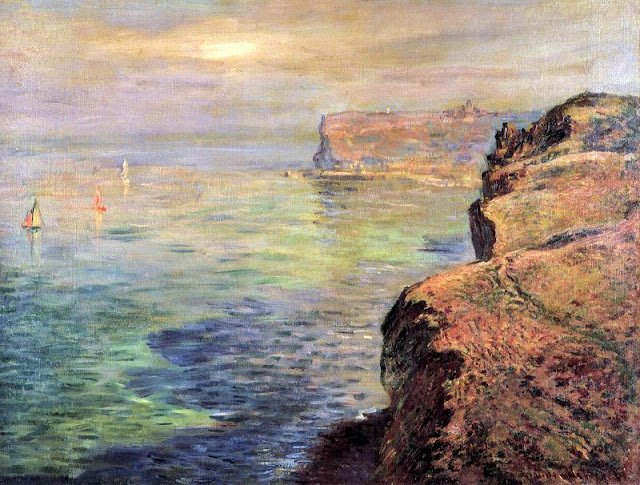the magpie. Realism. Orsay Museum. Paris (France.)
STREET STATION ST. LAZARE SEEN FROM THE TUNNEL BATIGNOLLES. Impressionism.
Oil on canvas. Private Collection. France.
Bordighera, ITALY. Impressionism. Oil on canvas. Private collection.
THE TURKEYS. Impressionism. Oil on canvas. Orsay Museum. Paris. France.
MORNING IN THE SEINE. Impressionism. Oil on canvas. Mead Art Museum. Amherst College. Massachusetts. USA.
What stations that had attracted the painters from the Impressionists to Turner, and even futuristic ...? Surely
the locomotive and the steam locomotive because it is a machine, a symbol of progress, of advancing civilization, motion, and the vapor because it has a "density" that makes the atmosphere is almost palpable, gives body and color involving men and things. A monet especially liked the sight of Saint-Lazare station, which was one of the grounds on which he worked from 1877
Manet had already devoted to a famous picture rail, in which a young girl contemplates the spectacle of the train surrounded by the white steam locomotives.
(This last paragraph, corresponds to the chart below: the Gare Saint-Lazare.)
Monet repeated the theme in its own way, highlighted the metal structure station and machinery, locomotives and steam that turns into a surreal vision, almost fantastic. The sky is framed by the triangle of the roof, in the center, the silhouette of the locomotives and wagons and travelers on the platforms. The whole is through vapor filter whitening luminous space, next to the blue smoke of the locomotive. Monet came to paint the subject in a series of canvases.
GRAINVAL NEAR FECAMP. Impressionism. Oil on canvas. Private Collection Norfolk. USA.
PRINTING, THE RISING SUN. Impressionism. Oil on canvas. Marmottan Museum. Paris (France.)
Impression, Rising Sun (French: Impression, soleil levant) is a painting by French painter Claude Monet, who gave his name to the Impressionist movement.
Dated 1872, but most likely painted in 1873, his motive is the port of Le Havre in France, using very few touches of brush that suggest rather than delineate. Monet explained the title later:
"The landscape is not nothing but an impression, an instant impression , Hence the title, the impression I got. I played an impression in Le Havre, from my window, sun in the fog and a few silhouettes of boats standing in the background ... I asked for a title for the catalog, I could not really be a view of Le Havre and said "put print"
Claude Monet painting was exhibited in 1874 during the first independent exhibition of the Impressionists, still known by that name. The critic Louis Leroy, inspired by the title of the painting, titled his hostile review in the newspaper Le Charivari, "Exhibition of the Impressionists" inadvertently naming the movement. Leroy wrote there:
"Printing .. I have no doubt. I said to myself, as I was impressed, there must be some print .. and what freedom, how easy crafts! The wallpaper in more embryonic state is more termination this seascape.
Louis Leroy
The painting was stolen from the Marmottan-Monet Museum in 1985 and regained in 1990. Since 1991 he has been back on display.
Monet painted the sun almost as luminance of the sky, a condition that suggests high humidity and atmospheric attenuation of light. This detail is based on the use of complementary colors and variety of color temperatures, rather than changes in intensity or contrasting values, to differentiate the sun from the sky around it. The painting is the value of simultaneous contrast of colors, warm tones placing on others opposed that highlights, in the retina of the viewer, on other tones. Vaporization is the fundamental element that pervades the area, noting that moisture invades the work and it reduces the tones, ie, the color is conditioned to the humid atmosphere. The main purpose of trying to get Monet in this work is to produce an impression on the viewer, so we find the importance attached to the viewer in impressionism. The strokes are somewhat free, fast and direct, reducing cuandro elements to simplify apparent, as envisaged in the reflections of the water. (Source: Wikipedia.)
BELLE ILE STORM OFF THE COAST.
ON THE EPTE Poplars.
Monet spent the spring, summer and autumn of 1891 to a series of paintings whose subjects are the cottonwoods lining the banks of the River Epte, about two miles from Giverny. The painted from a boat:
"At this point your boat I would greatly useful because I'm working on a series of pictures on the Epte and I'm very uncomfortable doing the Norwegian ... If the boat is stable and large enough, I could do a great service "(letter to Gustave Caillebotte Monet).
The July 28, 1891 Mallarme wrote:" I have a lot of work, a number of new tables stop. Besides, I have to admit that I find it hard to leave Giverny, especially now I'm fixing the house and garden to my taste. "
Successive repetitions of the subject reflect sometimes the stubborn insistence that Monet sought to trap air and light, while trying at the same time, carefully composing decoration but giving the impression of great simplicity.
Sources for tables: The City of painting. Sources
texts: Understanding the paint. Ediciones Orbis SA 1989 and Wikipedia.












































